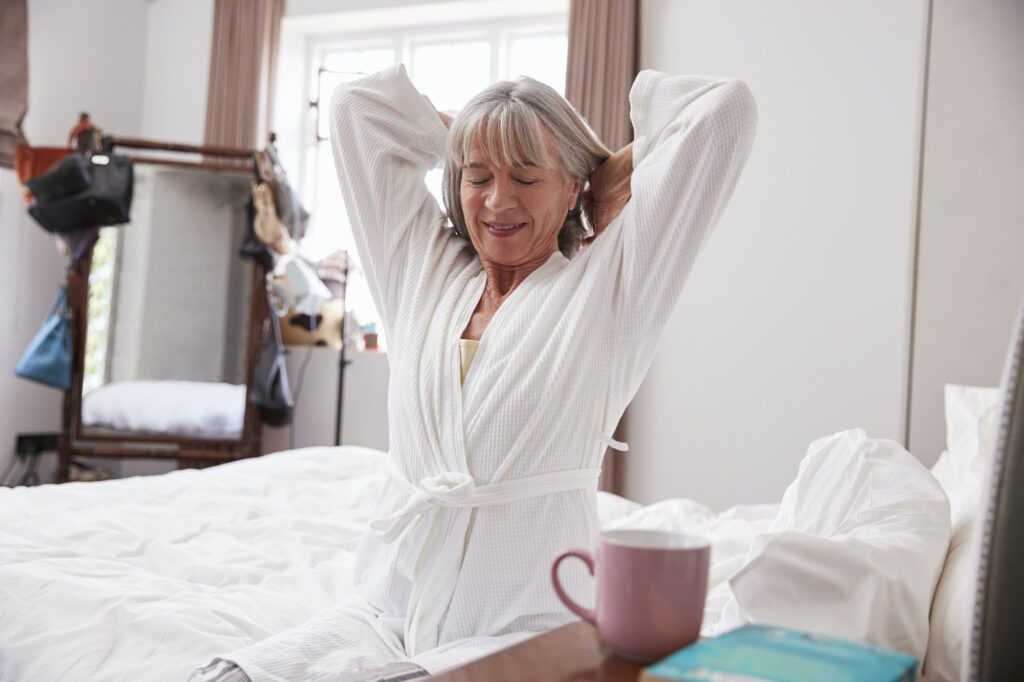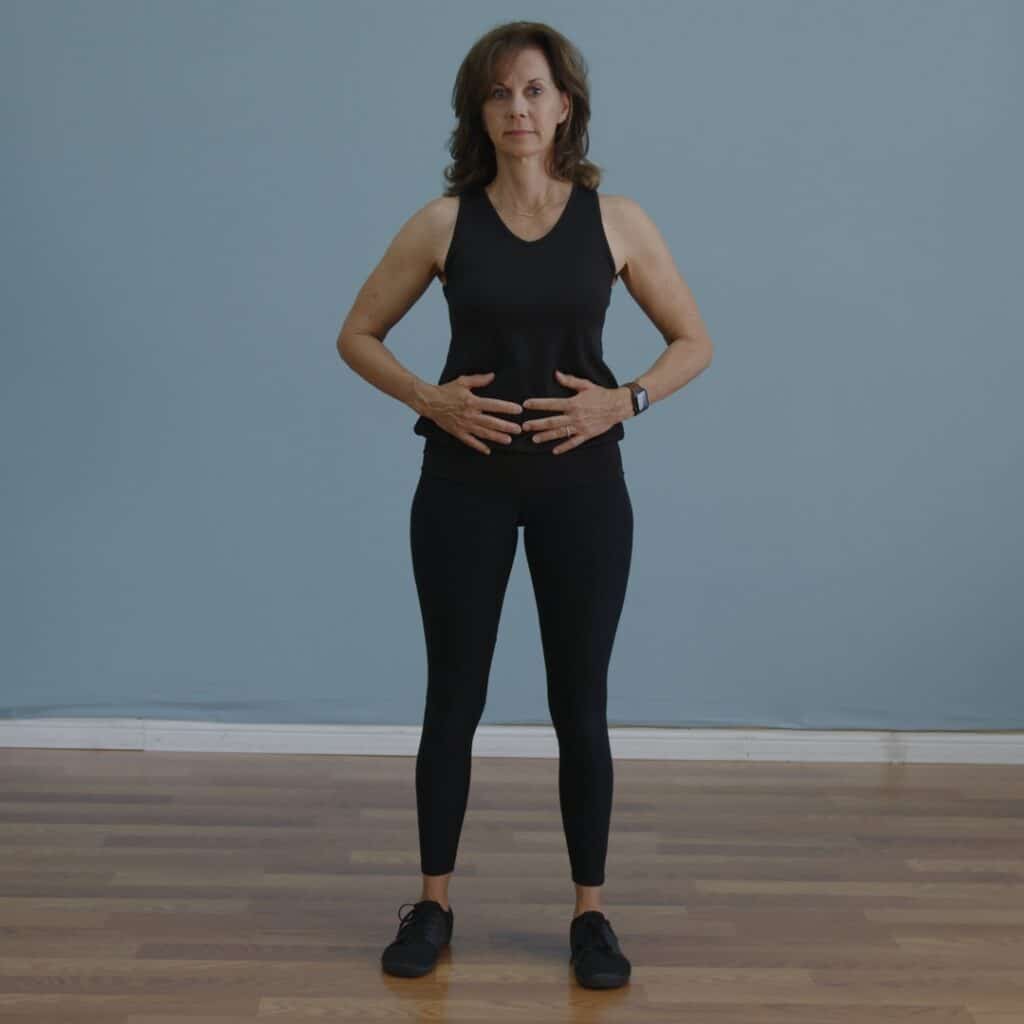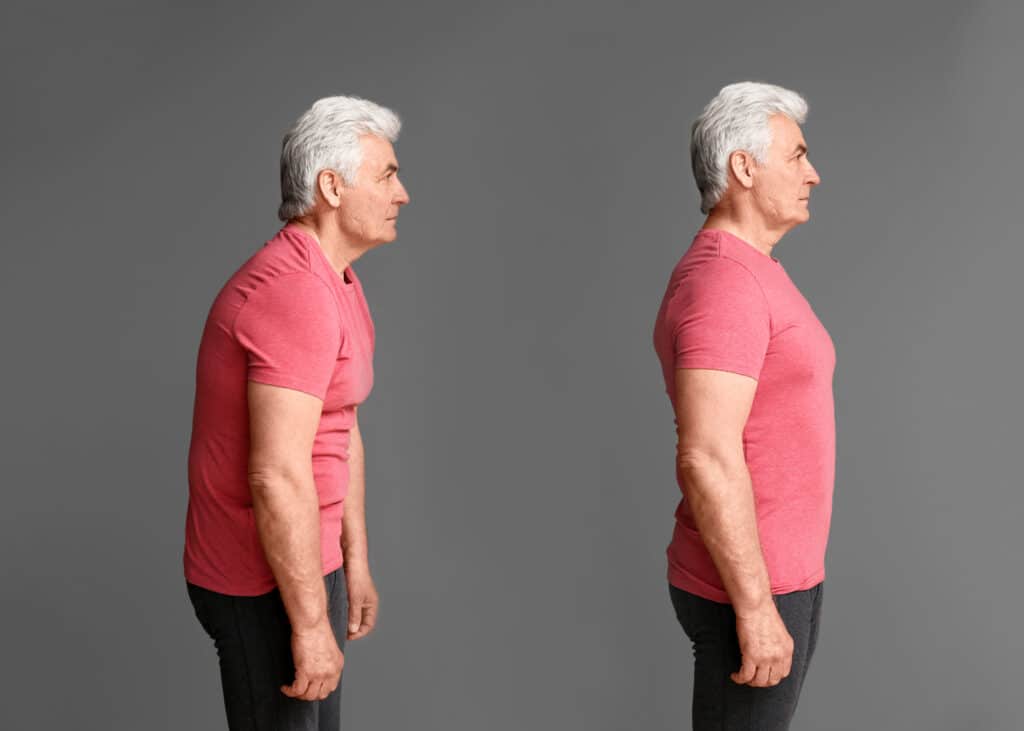Maintaining good posture is more essential for overall health and well-being than you may realize. Poor posture can lead to pain, discomfort, and limited mobility, especially for older people.
As we age, the natural deterioration of muscles, joints, and bones can worsen our posture, leading to back or neck pain or other issues.
Thankfully, targeted posture exercises and lifestyle changes make it possible to improve posture and enhance movement and stability well into your golden years.
The Importance of Good Posture
The term “correct posture” might be loosely defined as proper body alignment that allows all parts to work together efficiently.
When we maintain proper posture, we distribute our weight evenly across our body’s physical structures, reducing the strain on our muscles and joints. This is marked by the ability to maintain our center of gravity over our base of support. (1)
Optimal posture refers to the minimal muscle activity required to maintain proper function due to proper alignment in a seated or standing posture. Sub-optimal posture requires more effort from our muscles, joints, and ligaments. It can lead to discomfort and injury if left unaddressed.
Posture improvement promotes proper breathing and circulation. Conversely, poor posture can lead to muscle imbalances, pain, and limited mobility.
Factors That Affect Posture With Age
The natural effects of aging on the body can affect our posture, and age-related postural changes can increase your risk for instability and falls, resulting in other serious health problems. (1)
With age, muscles have a harder time maintaining and increasing their strength, and in turn, the body can have difficulty maintaining a correct position for good alignment.
Medical conditions like arthritis can have an impact as bones may become less dense and joints less flexible, making it more challenging to stay upright and mobile.
Lifestyle Factors
Lifestyle factors like sedentary behavior and minimal exercise can also contribute to poor posture at any age. Specifically, sitting too often without movement can cause various serious issues.
A prolonged seated position increases the risk of tight hip flexors and weak glute muscles. This combination leads to other muscular imbalances that can worsen the forward flexed — or stooped — posture commonly seen in older adults, resulting in low back pain and walking impairments.
Osteoporosis & Kyphosis
Older adults, especially older women, are at higher risk for developing osteoporosis.
Spinal degeneration may result in worsening thoracic kyphosis. With that can come an exaggerated curvature at the mid-back, a type of posture called hyperkyphosis, resulting in a hunched posture and a stronger inclination to lean forward.
Partnered with rounded shoulders, this causes weakness in the back muscles. This posture is typically accompanied by back and shoulder pain and difficulty reaching overhead. (2)
For more information on this topic, check out our article here about upper cross syndrome.
Vision Problems
Some research indicates that poor vision can also cause postural abnormalities.
Your vision helps keep your body in the right place in space within your surroundings. When vision diminishes with age, it may become harder to read small or distant print or see obstacles in front of us, resulting in a reaching-forward motion with the neck and head to get a closer look. (3)
Over time, this repetitive movement can result in a forward head posture, leading to pain or injury.

The Effects of Improving Your Posture
Improving posture can lead to better neck and shoulder motion, reducing the risk of pain and discomfort in those areas. By keeping your upper body in better alignment, you can optimize the range of motion in these joints allowing for better ease of movement.
Your lower body can also be affected in similar ways. Prolonged sitting can result in tight hip flexors and tight hamstrings, impairing your walking patterns and ability to stand fully erect.
With deliberate posture improvements, you can gain increased flexibility to improve your gait efficiency and stability while walking.
Better posture can also improve sitting tolerance and reduce strain on the spine. Sitting with your feet flat on the floor, arms supported, and a slight forward lean with lumbar support can decrease the pressure on your spinal discs. (2)
Similarly, organizing your sitting position for good posture in your car can prevent constant slouching, preventing driving-related pain.
How Good Posture Can Improve Daily Activities
Even a simple task, such as turning your head to look out the window while driving, can be more difficult due to poor posture.
Good posture can enhance overall movement and flexibility, making it easier to perform activities of daily living such as walking, standing, and lifting.
Other household activities that may become easier with better posture include:
Reaching overhead to put away dishes in the kitchen cabinets.
Carrying items from one room to the next.
Getting up and down from the floor while playing with your grandkids.
Better postural alignment allows you to move better, decreasing pain and lessening the forces of physical stress on your body.
Exercises to Improve Your Posture
While posture problems can result from many factors, they typically are worsened by a combination of physical misalignments throughout the body.
Exercises to strengthen and stretch muscles that support good posture, including the core, shoulders, back, and neck, can be effective. The following exercises can start you on the path to improved posture.
Although these are separate exercises, they work together for postural correction. For each, keep your weight balanced evenly over the center of your feet, with your legs bent to balance the effort in your leg muscles.
Please note: we recommend you consult your doctor before starting any exercise program.

Abdominal Breathing Engagement
Moving upward from the hips, the following exercise complements the previous movement to begin engaging the midsection for core stability.
In the same standing position, place your hands around your waist at around belly button height.
Take a deep inhale into your midsection as if breathing into your hands.
Exhale through your mouth as if you are blowing out a candle. As you do so, notice that your waist gets smaller between your hands. You should feel a lot of engagement throughout your stomach muscles.
Without holding your breath, continue breathing normally without releasing the cinched waist you’ve created between your hands.
This exercise encourages more engagement from your deep core, specifically an important muscle called the transverse abdominus. Try this exercise with the pelvic tilt movement several times a day.

Chin Tucks
This exercise stretches the back of the neck while engaging muscles that can become overstretched in the front of the neck due to forward head posture.
Standing up or sitting tall in a chair, draw your chin straight back as if trying to create a double chin.
Hold briefly, then repeat. Ideally, you feel a slight pulling upward sensation from the back of the neck as if you’re getting a little taller.
This is a small but essential motion and also works exceptionally well with the abdominal breathing exercise.
Cat-Cow
Finally, the cat-cow motion is helpful for various reasons, but in this case, it is used to mobilize under-used parts of the back and neck.
On all fours, inhale as you drop your belly toward the ground, bringing your gaze subtly forward.
Then exhale as you round your back, looking down and back between your wrists.
Repeat 8-10 times with your movement following your breath.
Focus on your hips and middle back movement, and try to minimize excessive movement in your neck. If you feel pain in any of these areas, discontinue the exercise.
Other Ways to Improve Your Posture
Physical therapy
If you’re still unsure how to start or encountering pain from poor posture, visiting a physical therapist for a postural evaluation and assessment can be extremely helpful.
An individualized program, including personalized exercises, may be prescribed by your PT. Yoga, pilates, and other forms of exercise that promote proper alignment and body awareness can also be helpful once the initial corrections have been made.
Lifstyle modification
Lifestyle changes promoting good posture, including maintaining a healthy weight and avoiding prolonged sitting, are essential.
Many phone and computer apps are also widely available to help you monitor sleep, food consumption, and exercise schedules, among other important health markers.
Postural training devices
Posture training devices, such as braces or specialized chairs, can sometimes improve posture. Still, they should not be used as your only posture correction tool.
In my clinical practice, I have seen the most success with patients who use taping techniques or devices that provide a simple postural cue. These methods gently encourage better posture to teach you better postural awareness without relying on a device for support.
Overreliance on external devices can result in dependency, so the use of posture correction devices should be discussed with your physical therapist.
Much more research remains left to be done on technologies that can help with postural corrections. (4)
Summary
Maintaining good posture is essential for overall health, stability, and proper physical functioning. Poor posture can lead to pain, discomfort, and limited mobility. Age-related changes can impact posture negatively.
However, through targeted exercises and lifestyle changes, it is possible to improve posture and enhance movement.
Incorporating these strategies into your daily life can improve your posture and help you to lead a healthier, more active life.
Resources:
Rath, R., & Wade, M. G. (2017). The Two Faces of Postural Control in Older Adults: Stability and Function. EBioMedicine, 21, 5–6. https://doi.org/10.1016/j.ebiom.2017.03.030
Katzman, W. B., Wanek, L., Shepherd, J. A., & Sellmeyer, D. E. (2010). Age-related hyperkyphosis: its causes, consequences, and management. The Journal of Orthopaedic and sports physical therapy, 40(6), 352–360. https://doi.org/10.2519/jospt.2010.3099
Poulain, I., & Giraudet, G. (2008). Age-related changes of visual contribution in posture control. Gait & posture, 27(1), 1-7.
Katzman, W. B., Gladin, A., Lane, N. E., Wong, S., Liu, F., Jin, C., & Fukuoka, Y. (2019). Feasibility and Acceptability of Technology-Based Exercise and Posture Training in Older Adults With Age-Related Hyperkyphosis: Pre-Post Study. JMIR aging, 2(1), e12199. https://doi.org/10.2196/12199





